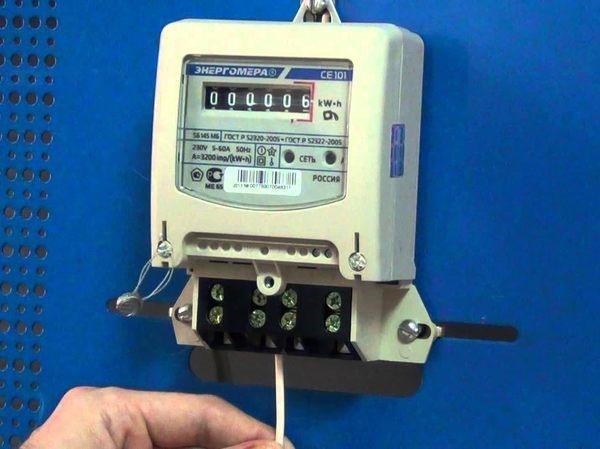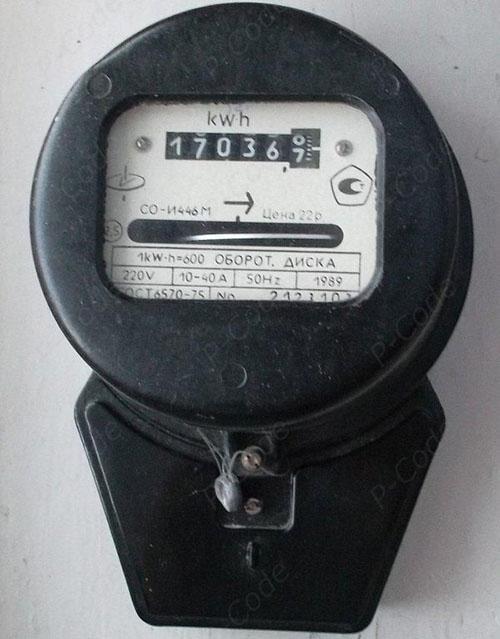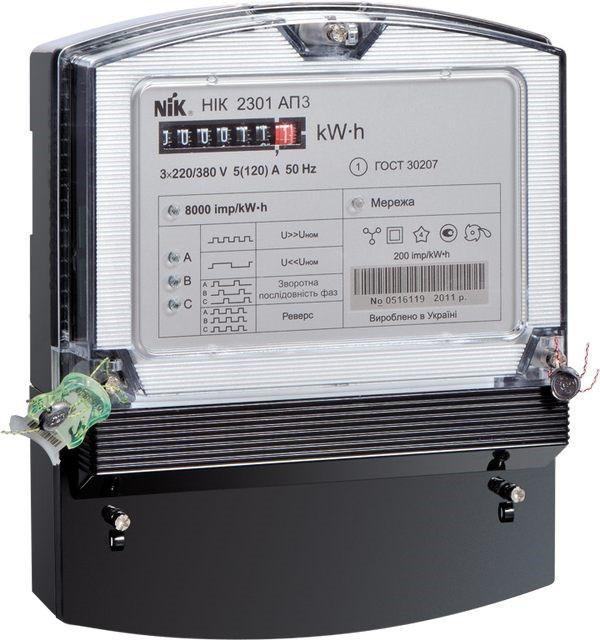We make the connection of the meter, observing all the rules
 To account for the consumed electricity, special devices are used - electricity meters. Do-it-yourself electricity meter connection is made according to certain rules.
To account for the consumed electricity, special devices are used - electricity meters. Do-it-yourself electricity meter connection is made according to certain rules.
The device and principle of operation of the electric meter
The principle of electricity metering is the same in devices of different types, but according to their device they are divided into induction and electronic.
Induction or electromechanical meter

- voltage connected in parallel with the load and measuring the mains voltage;
- current, connected in series with the load.
The higher the current or voltage, the faster the aluminum disc rotates, transmitting the rotation through a worm gear to a mechanical digital display. To reduce the inertia of the disk, there is a permanent magnet inside the device, which slows it down with its field.
Through various manipulations, such metering devices can be made to rotate in the opposite direction. Therefore, the power supply companies are replacing them with new, electronic ones.
Electronic metering device
 An electronic electricity meter converts the measured power into an analog signal and, further, into a digital one.
An electronic electricity meter converts the measured power into an analog signal and, further, into a digital one.
The main part of this device is a microcontroller that keeps track of the consumed electricity. It transmits a signal to a liquid crystal display or electromechanical display, as well as to the ASKUE system (automated system for monitoring and metering electricity).
These meters have built-in anti-rotation protection and anti-magnetic seals.
Electricity metering devices connection diagrams
The meter connection to the mains depends on the number of phases and the measured current and voltage and does not depend on the design of these devices. Terminal blocks in these devices are sealed by power grid controllers.
Single-phase electricity meters
 The connection of a single-phase meter is made through a sealed terminal block. When using current or voltage transformers, the secondary windings of the transformers are connected to it. There are four terminals on the terminal block:
The connection of a single-phase meter is made through a sealed terminal block. When using current or voltage transformers, the secondary windings of the transformers are connected to it. There are four terminals on the terminal block:
- incoming phase wire;
- outgoing phase;
- incoming neutral wire;
- outgoing zero.
The following figure shows the connection diagram of the electricity meter.
How to connect a three-phase meter
 These devices are structurally three single-phase meters in one housing.
These devices are structurally three single-phase meters in one housing.
Induction meters have three aluminum discs on one axis, while electronic meters have a common board.
There are six phase terminals on the terminal block, located in pairs - three incoming and three outgoing and the seventh, zero. Similar to single-phase meters, they are switched on directly or through a transformer. Some models have two zero terminals. The connection diagram for a two-phase meter is a cut-off version of a three-phase one.
The connection of a three-phase meter in a private house is carried out in agreement with the power supply organization.
Turning on electricity meters through transformers
 If it is necessary to measure the power in networks, the current or voltage in which exceeds the permissible for the used metering devices, the meter is connected through current and voltage transformers.
If it is necessary to measure the power in networks, the current or voltage in which exceeds the permissible for the used metering devices, the meter is connected through current and voltage transformers.
The consumed electricity is calculated by multiplying the meter readings by the transformation ratio.
How to properly install an electric meter
Installation and connection of electricity meters is carried out in accordance with Chapter 1.5 of the PUE.
Term of state verification
 When purchasing an electric meter and installing it, you should check the presence of the state verification seal and its date. This seal is located on the body of the device, in contrast to the seal of the electric company located on the terminal block.
When purchasing an electric meter and installing it, you should check the presence of the state verification seal and its date. This seal is located on the body of the device, in contrast to the seal of the electric company located on the terminal block.
The quarter is indicated in Roman numerals, and the year of the state verification date on the reverse side. According to the PUE, the period between the state verification and sealing of the meter at the installation site should be no more than a year for a 3-phase device and two for a single-phase one. It does not matter whether the device was in operation.
Electric meter installation
 Despite the fact that the installation of such devices is allowed to be carried out at a height of 0.8-1.7 meters, most often it is done so that the display is at a level convenient for taking readings and checking the integrity of the seals.
Despite the fact that the installation of such devices is allowed to be carried out at a height of 0.8-1.7 meters, most often it is done so that the display is at a level convenient for taking readings and checking the integrity of the seals.
The meter is installed vertically, with a maximum deviation of 1 °. This rule was established for induction meters, the accuracy of which depended on position, but was not canceled with the advent of electronic devices, for which this does not matter.
If the induction meter is placed in a horizontal position, it stops. Therefore, the fastening of such devices was sealed by the inspectors of Energonadzor.
Primary requirements
 The basic rules for the installation and connection of metering devices are determined by cl. 1.5.27-1.5.29 PUE.
The basic rules for the installation and connection of metering devices are determined by cl. 1.5.27-1.5.29 PUE.
According to these rules, the electricity meter should be located in a place convenient for both home owners and inspectors of the electrical company. Most often it is installed in the corridor or at the front door. You should also take into account external conditions - temperature, humidity, and others. In Soviet-built multi-storey buildings, such devices were located in the dashboard at the entrance.
The devices are mounted on a rigid base, in an open or closed panel, in an electrical cabinet or directly on the wall.
How to connect an electricity meter in a private house on the street
 The rules for installing an electric meter in a private house on the street do not differ from the rules for in-house installation. However, at low temperatures, the device may show incorrect data. Therefore, for outdoor installation, according to PUE 1.5.27, the shield must be insulated and heated.
The rules for installing an electric meter in a private house on the street do not differ from the rules for in-house installation. However, at low temperatures, the device may show incorrect data. Therefore, for outdoor installation, according to PUE 1.5.27, the shield must be insulated and heated.
In addition, not only owners and inspectors, but also unauthorized persons will have access to the dashboard. Despite this, in some cases, power supply companies require the installation of the panel on the street. This makes it easier to control the integrity of the seals and take readings.
Multi-tariff electricity meters
 Electricity consumption is uneven at different times of the day. Therefore, in order to reduce electricity consumption during peak hours, electric companies propose the installation of two-tariff electricity meters.
Electricity consumption is uneven at different times of the day. Therefore, in order to reduce electricity consumption during peak hours, electric companies propose the installation of two-tariff electricity meters.
These metering devices take into account the consumed energy with an increasing or decreasing coefficient. It depends on the time of day and the setting of the device. Specific values vary from region to region.
Two-zone tariff:
- in the afternoon with a ratio of 1: 1;
- at night, 23.00-7.00 coefficient is reduced.
Three-zone tariff:
- in the afternoon, 10.00-17.00 and 21.00-23.00, the ratio is 1: 1;
- during peak hours, 7.00-10.00 and 17.00-23.00, the coefficient is increased;
- at night, during the hours of minimum load, 23.00-7.00, the energy is the cheapest, with a reduction factor.
Such appliances help to reduce the energy bill, especially if you include powerful loads such as washing machines, dishwashers or boilers during the cheapest hours.
Despite the fact that such devices and their programming are more expensive than single-zone ones, it is beneficial. The combination of electric heating and a two-tariff meter is especially effective.
It is not difficult to connect the electricity meter yourself. It is important to comply with all the rules of the PUE, otherwise the inspector of the electrical company will force you to redo the work, which will lead to additional costs and loss of time.